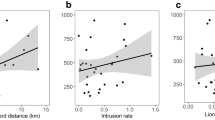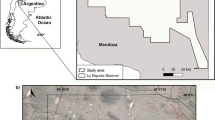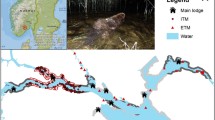Abstract
Neighbour–stranger discrimination occurs when individuals respond with more aggression to strangers than to territorial neighbours—a phenomenon termed the “dear enemy phenomenon” (DEP). We investigated the DEP with male and female root voles (Microtus oeconomus Pallas 1776) using field dyadic arena tests conducted in enclosures where we could test for the effects of familiarity (familiar versus stranger), ownership (resident versus intruder status) and resource-holding potential (body mass) on territorial behaviours. The results showed that males put more effort into territorial defence than females, and males could discriminate between neighbours and strangers. In males, aggressiveness was influenced by a significant two-way interaction between treatment and ownership. Male residents were more aggressive towards stranger intruders than towards neighbour intruders, while male intruders were less aggressive towards stranger residents than towards neighbour residents. In females, neither treatment nor ownership status had a significant effect on aggressiveness. Familiar males performed more social behaviours but less non-social behaviours than stranger males. Furthermore, there was a clear dominance hierarchy between residents and intruders in stranger dyads, with the male territory holders dominating the intruder in pairwise interactions. To our knowledge, these results demonstrate for the first time DEP in a small mammal with a known pedigree and present the first evidence for “prior resident advantage” in voles. We argue that both ownership status and familiarity status affect how much an individual invests in territory defence. The benefits of neighbour–stranger discrimination for male root voles and the absence of neighbour–stranger discrimination in female root voles are discussed.


Similar content being viewed by others
References
Aars J, Ims RA (2000) Population dynamic and genetic consequences of spatial density-dependent dispersal in patchy populations. Am Nat 155:252–265
Aars J, Andreassen HP, Ims RA (1994) The use of fluorescent pigments to establish mother–offspring relationships in small mammals. Mammalia 58:649–655
Agrell J, Wolff JO, Ylonen H (1998) Counter-strategies to infanticide in mammals: costs and consequences. Oikos 83:507–517
Andreassen HP, Gundersen (2006) Male turnover reduces population growth: an enclosure experiment on voles. Ecology 87:88–94
Andreassen HP, Ims RA (2001) Dispersal in patchy vole populations: role of patch configuration, denisty dependence, and demography. Ecology 82:2911–2926
Andreassen HP, Hertzberg K, Ims RA (1998) Space-use responses to habitat fragmentation and connectivity in the root vole Microtus oeconomus. Ecology 79:1223–1235
Archer J (1987) The behavioural biology of aggression. Cambridge University Press, Cambridge
Bard S, Hau M, Wikelski M, Winglfield JC (2002) Vocal distinctiveness and response to conspecific playback in the spotted antbird, a neotropical suboscine. Condor 104:387–394
Boonstra R, Krebs CJ, Gaines MS, Johnson ML, Craine ITM (1987) Natal philopatry and breeding systems in voles (Microtus spp.). J Anim Ecol 56:655–673
Dobson FS (1982) Competition for mates and predominant juvenile male dispersal in mammals. Anim Behav 30:1183–1192
Ebsensperger LA (1998) Strategies and counterstrategies to infanticide in mammals. Biol Rev 73:321–346
Ferkin MH (1988) The effect of familiarity on social interactions in meadow voles, Microtus pennsylvanicus: a laboratory and field study. Anim Behav 36:1816–1822
Fisher J (1954) Evolution and bird sociality. In: Huxley J, Hardy AC, Ford EB (eds) Evolution as a process. Allen and Unwin, London, pp 71–83
Fox J (2002) An R and S plus companion for applied regression. Sage, London
Getty T (1987) Dear enemies and the prisoners-dilemma—why should territorial neighbours form defensive coalitions. Am Zool 27:327–336
Gundersen G, Andreassen HP (1998) Causes and consequences of natal dispersal in root voles, Microtus oeconomus. Anim Behav 56:1355–1366
Hansteen TL, Andreassen HP, Ims RA (1997) Effects of spatiotemporal scale on autocorrelation and home range estimators. J Wildl Manag 61:280–290
Hoset KS, Le Galliard JF, Gundersen G, Steen H (2008) Home range size and overlap in female root voles: the effects of season and density. Behav Ecol 19:139–145
Hovland N, Andreassen HP (1995) Fluorescent powder as dye in bait for studying foraging areas in small mammals. Acta Theriol 40:315–320
Ims RA (1987) Responses in the spatial organization and behaviour to the food resources in the vole Clethrionomys rufocanos. J Anim Ecol 56:555–596
Ims RA (1997) Determinants of geographic variation in growth and reproductive traits in the root vole. Ecology 78:461–470
Ims RA, Andreassen HP (1999) Effects of experimental habitat fragmentation and connectivity on root vole demography. J Anim Ecol 68:839–852
Ims RA, Rolstad J, Wegge P (1993) Predicting space use responses to habitat fragmentation—can voles Microtus oeconomus serve as an experimental-model system (EMS) for capercaillie grouse Tetrao urogallus in boreal forest. Biol Conserv 63:261–268
Jaeger RG (1981) Dear enemy recognition and the costs of aggression between salamanders. Am Nat 117:962–974
Kemp DJ, Wiklund C (2004) Fighting without weaponry: a review of male–male contest competition in butterflies. Behav Ecol Sociobiol 49:429–442
Kokko H, López-Sepulcre A, Morrell LJ (2006) From hawks and doves to self-consistent games of territorial behavior. Am Nat 167:901–912
Koskela E, Mappes T, Ylonen H (1997) Territorial behaviour and reproductive success of bank vole Cletherionomys glarelous females. J Anim Ecol 66:341–349
Krebs JR (1982) Territorial defence in the great tit (Parus major): do residents always win? Behav Ecol Sociobiol 11:185–194
Lambin X, Krebs CJ, Scott B (1992) Spacing system of the tundra vole (Microtus oeconomus) during the breeding season in Canada western arctic. Can J Zool 10:2068–2072
Le Galliard JF, Gundersen G, Andreassen HP (2006) Natal dispersal, interactions among siblings and intrasexual competition. Behav Ecol 17:733–740
Luque-Larena JJ, Lopez P, Gosalbez J (2002) Levels of social tolerance between snow voles Chionomys nivalis during over-wintering periods. Acta Theriol 47:163–173
Maynard Smith J (1982) Evolution and the theory of games. Cambridge University Press, Cambridge
Maynard Smith J, Parker GA (1976) The logic of asymmetric contest. Anim Behav 24:159–175
McCullagh P, Nelder JA (1989) Generalized linear models, 2nd edn. Chapman & Hall, London
McGuire B, Getz L (1998) The nature and frequency of social interactions among free-living prairie voles (Microtus ochrogaster). Behav Ecol Soc 43:271–279
Mills SC, Grapputo A, Koskela E, Mappes T (2007) Quantitative measure of sexual selection with respect to the operational sex ratio: a comparison of selection indices. Proc R Soc Lond Ser B 274:143–150
Ostfeld RS (1985a) Limiting resources and territoriality in microtine voles. Am Nat 126:1–15
Ostfeld RS (1985b) Experimental analysis of aggression and spacing behavior in California voles. Can J Zool 63:2277–2282
Parker GA (1974) Assessment strategy and the evolution of fighting behaviour. J Theor Biol 47:223–243
Sokal RR, Rohlf FJ (1995) Biometry. The principles and practice of statistics in biological research, 3rd edn. W. H. Freeman and Company, New York
Solomon NG, Jacquot JJ (2002) Testing functional hypotheses for wandering in prairie voles, Microtus ochrogaster. Can J Zool 80:951–955
Steen H (1994) Low survival of long-distance dispersers of the root vole (Microtus oeconomus). Annal Zool Fenn 31:271–274
Stoddard PK (1996) Chapter 20: Vocal recognition in territorial passerines. In: Kroodsma DE, Miller EH (eds) Ecology and evolution of acoustic communication in birds. Cornell University Press, Ithaca, NY, pp 356–374
Stokkebo S, Hardy ICW (2000) The importance of being gravid: egg load and contest outcome in a parasitoid wasp. Anim Behav 59:1111–1118
Tast J (1966) The root vole, Microtus oeconomus (Pallas), as an inhabitant of seasonally flooded land. Annal Zool Fenn 3:127–171
Temeles EJ (1994) The role of neighbours in territorial systems: when are they ‘dear enemies’? Anim Behav 47:339–350
Venables WN, Ripley BD (2002) Modern applied statistics with S. Springer, Berlin
Vestal BM, Hellack JJ (1978) Comparison of neighbor recognition in two species of deer mice (Peromyscus). J Mammal 59:339–346
Wolff JO (1985) Behavior. In: Tamarin RH (ed) Biology of new world Microtus. American Society of Mammalogists, New York, pp 340–372 (Special publication no. 8)
Wolff JO, Freeberg MH, Dueser RD (1983) Interspecific territoriality in two sympatric species of Peromyscus (Rodentia: Cricetidae). Behav Ecol Soc 12:237–242
Ydenberg RC, Giraldeau LA, Falls JB (1988) Neighbors, strangers, and the asymmetric war of attrition. Anim Behav 36:343–347
Acknowledgment
We acknowledge the kind help of K. Hoset and L. Korslund who provided the breeding pairs used in our experiment. We thank F. Bergan for excellent help in the field. The study was supported financially by Telemark University College funding to F. R., a grant from the Research Council of Norway project “Mechanisms of species co-existence in patchy habitats” to G. G. and a grant from the Sixth Framework Programme of the European Commission (Marie Curie Intra-European Fellowship FP6-501658) to J.-F.L.G. The housing at the Animal Division and experimentations at Evenstad Research Station were done in accordance with the Norwegian “Animal Welfare Act” (#73) of 20.12.74, the Norwegian “Regulation on Animal Experimentation” of 15.01.96 and the European Convention for the Protection of Vertebrate Animals used for Experimental and Other Scientific Purposes of 18.03.86.
Author information
Authors and Affiliations
Corresponding author
Additional information
Communicated by P. Banks
Rights and permissions
About this article
Cite this article
Rosell, F., Gundersen, G. & Le Galliard, JF. Territory ownership and familiarity status affect how much male root voles (Microtus oeconomus) invest in territory defence. Behav Ecol Sociobiol 62, 1559–1568 (2008). https://doi.org/10.1007/s00265-008-0585-5
Received:
Revised:
Accepted:
Published:
Issue Date:
DOI: https://doi.org/10.1007/s00265-008-0585-5




